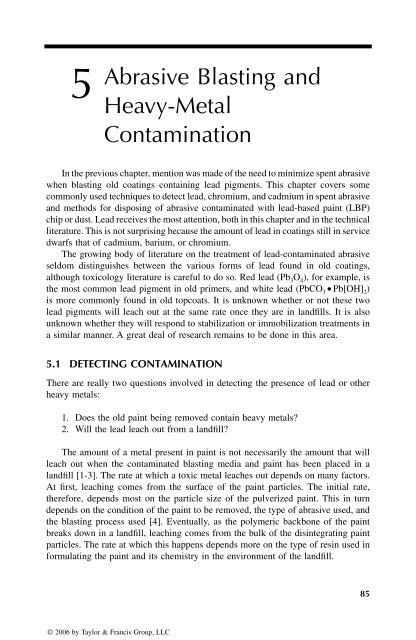© 2006 by Taylor & Francis Group, LLC
© 2006 by Taylor & Francis Group, LLC
© 2006 by Taylor & Francis Group, LLC
Create successful ePaper yourself
Turn your PDF publications into a flip-book with our unique Google optimized e-Paper software.
5<br />
Abrasive Blasting and<br />
Heavy-Metal<br />
Contamination<br />
In the previous chapter, mention was made of the need to minimize spent abrasive<br />
when blasting old coatings containing lead pigments. This chapter covers some<br />
commonly used techniques to detect lead, chromium, and cadmium in spent abrasive<br />
and methods for disposing of abrasive contaminated with lead-based paint (LBP)<br />
chip or dust. Lead receives the most attention, both in this chapter and in the technical<br />
literature. This is not surprising because the amount of lead in coatings still in service<br />
dwarfs that of cadmium, barium, or chromium.<br />
The growing body of literature on the treatment of lead-contaminated abrasive<br />
seldom distinguishes between the various forms of lead found in old coatings,<br />
although toxicology literature is careful to do so. Red lead (Pb 3O 4), for example, is<br />
the most common lead pigment in old primers, and white lead (PbCO 3 • Pb[OH] 2)<br />
is more commonly found in old topcoats. It is unknown whether or not these two<br />
lead pigments will leach out at the same rate once they are in landfills. It is also<br />
unknown whether they will respond to stabilization or immobilization treatments in<br />
a similar manner. A great deal of research remains to be done in this area.<br />
5.1 DETECTING CONTAMINATION<br />
There are really two questions involved in detecting the presence of lead or other<br />
heavy metals:<br />
1. Does the old paint being removed contain heavy metals?<br />
2. Will the lead leach out from a landfill?<br />
The amount of a metal present in paint is not necessarily the amount that will<br />
leach out when the contaminated blasting media and paint has been placed in a<br />
landfill [1-3]. The rate at which a toxic metal leaches out depends on many factors.<br />
At first, leaching comes from the surface of the paint particles. The initial rate,<br />
therefore, depends most on the particle size of the pulverized paint. This in turn<br />
depends on the condition of the paint to be removed, the type of abrasive used, and<br />
the blasting process used [4]. Eventually, as the polymeric backbone of the paint<br />
breaks down in a landfill, leaching comes from the bulk of the disintegrating paint<br />
particles. The rate at which this happens depends more on the type of resin used in<br />
formulating the paint and its chemistry in the environment of the landfill.<br />
<strong>©</strong> <strong>2006</strong> <strong>by</strong> <strong>Taylor</strong> & <strong>Francis</strong> <strong>Group</strong>, <strong>LLC</strong><br />
85
















